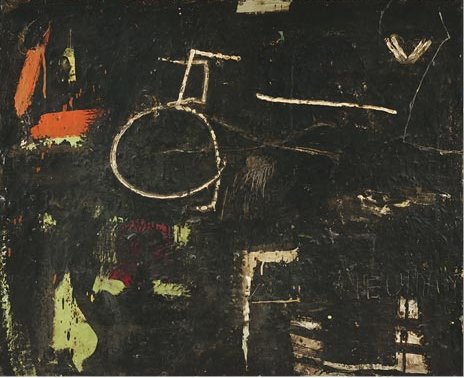Robert S. Neuman
dal 11/1/2006 al 3/3/2006
Segnalato da
11/1/2006
Robert S. Neuman
Allan Stone Gallery, New York
Fifty Years. The exhibition explores abstract thematic artist's work from the early Black Paintings reflecting the post-World War II mood, to Ship to Paradise, a series of whimsical drawings illustrating man's journey to paradise, to the more recent Lame Deer series, which reflects the Native American experience. The works fuse aspects from the Bay Area School with elements of German Expressionism and postwar European painting.

Fifty Years
Robert S. Neuman: Fifty Years will be on view at the Allan Stone Gallery from January 12 to March 4, 2006. The exhibition explores abstract thematic painter Robert S. Neuman’s work from the early Black Paintings reflecting the post-World War II mood, to Ship to Paradise, a series of whimsical drawings illustrating man’s journey to paradise, to the more recent Lame Deer series, which reflects the Native American experience.
Robert S. Neuman pushes the balance of content and form in his work almost to the border of symbolism. The work fuses aspects from the Bay Area School—broad surface treatment, full-color palette, and atmospheric light—with elements of German Expressionism and postwar European painting.
Neuman’s series are often based on a single inciting incident, working from experience to abstraction. He uses themes: some literal, others more inspired by the European tradition of painting the emotional impact of visual experience.
In 1953, Neuman moved to Stuttgart, Germany, on a Fulbright grant to study with Willi Baumeister. His firsthand experience of postwar devastation led to the Black Paintings, his first series. The paint was applied with broad brush strokes, giving the canvas a thick texture intensified by sporadically poured paint. By scraping and scratching directly onto the canvas, Neuman brought drawing into his painting, which became a constant in his work.
Neuman went to Barcelona, Spain, on a Guggenheim Fellowship in 1956. At first he continued to use a dark palette, but the light of the Costa Del Sol, combined with the mysticism embedded in the everyday life of southern Europe brought about a change. In the Barcelona Paintings Neuman’s color palette moved toward glowing reds, oranges, sharp yellows and greens combined with off-whites, pale grays and browns. Black, the predominant color in his previous series, gradually disappeared.
The element of light - from a moment of sunshine he saw pouring into an alley - exploded into every picture and became the main structural component. Most of the Barcelona Paintings have a central vertebrae running vertically through the middle. “The paintings have an architectural structure, because they came from architecture," explains Neuman.
The early Barcelona Paintings reflect an Abstract Expressionist tradition - broad brush strokes, energetic paint handling, gestural surfaces - and evolved in the late 1960s into Geometric Abstraction.
Meditations on the fragmentation of the world—in terms of liquids and solids, language, cultures, and continents—inspired the Pedazos del Mundo series in the early 1960s. The circular symbol emerged here and continued to be an important element in his body of work.
The Pedazos del Mundo series led into the Space Sign (1966) series, where Neuman focused on taking away the importance of the center, and putting in its place many circular forms suspended in space. “I thought of it as pieces, you see, pieces that had escaped from the world," says Neuman.
In the Voyage series, which began in 1972, Neuman worked through a personal evolution. It was the first time his love of drawing was fully reflected in his mature work.
On a trip to Granada, Spain in 1979, Neuman was inspired by light falling on and through Moorish architecture to create the Alhambra series. “They have these columns in the Alhambra which are constantly breaking your view. So I kept seeing this space interrupted by these vertical things. And I carried that into the paintings," says Neuman.
In the Rose Paintings, he started in the early 1980s, Neuman explored painting without shape, using only light, surface and color to evoke the quality of a flower.
The Ship to Paradise series (1983) of thirteen etchings, lithographs, and drawings followed the journey to paradise along a whimsical narrative surrealistic route.
In Lame Deer, Montana, the barren countryside led Neuman to meditate on the rich and devastating Native American history. The Lame Deer series reflects an aspect of Americana through its use of Indian teepees as symbols in the chromatic landscape. They were chosen for their structural attitude. “There is no skin over them, just the sticks. Like somebody lived there once but they don’t anymore," says Neuman.
Born in the mining town of Kellogg, Idaho in 1926, Robert S. Neuman began drawing as a child when he illustrated stories he heard over the radio. After an honorable discharge from the Air Force in 1946, he received his BA in applied art and his MFA in 1951 from the California College of Arts and Crafts in Oakland, California. In 1953, Neuman was awarded a Fulbright grant to study with Willi Baumeister in Germany. He has taught at Brown University and Harvard University, and was Chairman of the Art Department at Keene State College in New Hampshire from 1972-1990. His work has been exhibited at museums and galleries worldwide, and is in the permanent collections of the Museum of Modern Art, the Fogg Art Museum, The Carnegie Museum, The Yale University Collection, San Francisco Museum of Modern Art, the DeCordova Museum, Library of Congress, The New York Public Library, and others. He lives in Winchester, Massachusetts and Northeast Harbor, Maine.
Imge: Small black painting, 1952, oil on masonite, 99,6 x 12,9 cm
Opening: January 12
Allan Stone Gallery
113 East 90th Street - New York



